Fresh sea breezes carrying hints of salt. Soft golden sands. Waves washing over me in a rhythmic dance. The ocean is, without a doubt, one of my favorite places on earth. I could spend all day leaping through the waves and diving under currents and getting dunked onto the sandy beach, captivated by every single crest of water as if it was the first one I’ve ever seen.
You can imagine the thrill that went through me when I was hunting for a new piano piece and I found this gem. Une Barque sur L’Ocean. A Boat on the Ocean. The OCEAN. L’OCEAN.

a painting by my Grandma
Two seconds into the recording and I could taste salt on my lips, feel my hair being swept back by the sea’s sprays, and absorb the ocean into my skin.
Seven minutes later and I was a salt-water puddle of joy.
Determined to perform this piece for the upcoming Spring recital, I quickly got my hands on a score of the music and promptly dissolved into a puddle of horror and despair.
For starters, this piece is eighteen pages long. Eighteen. All of which I would have to memorize.
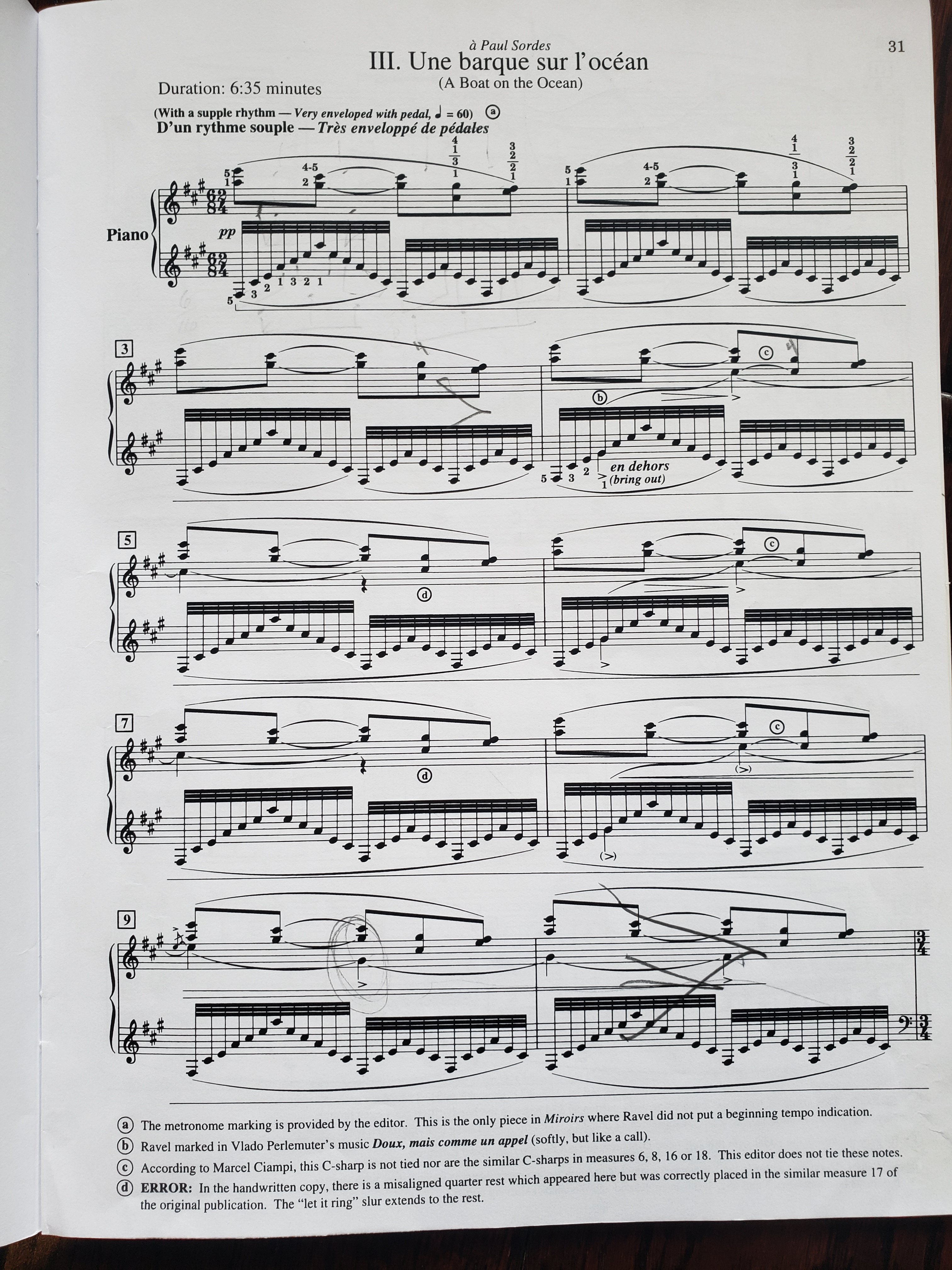
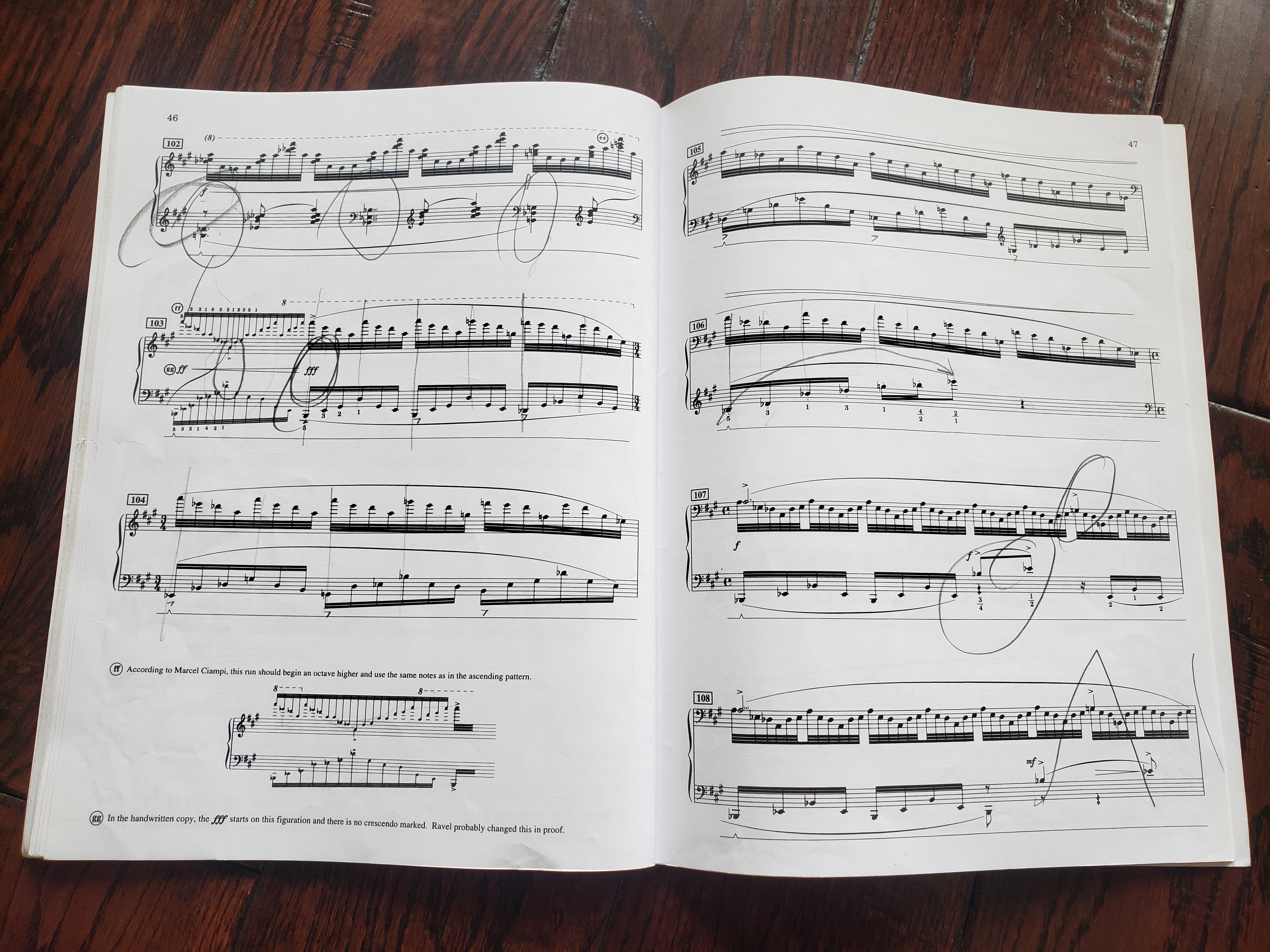

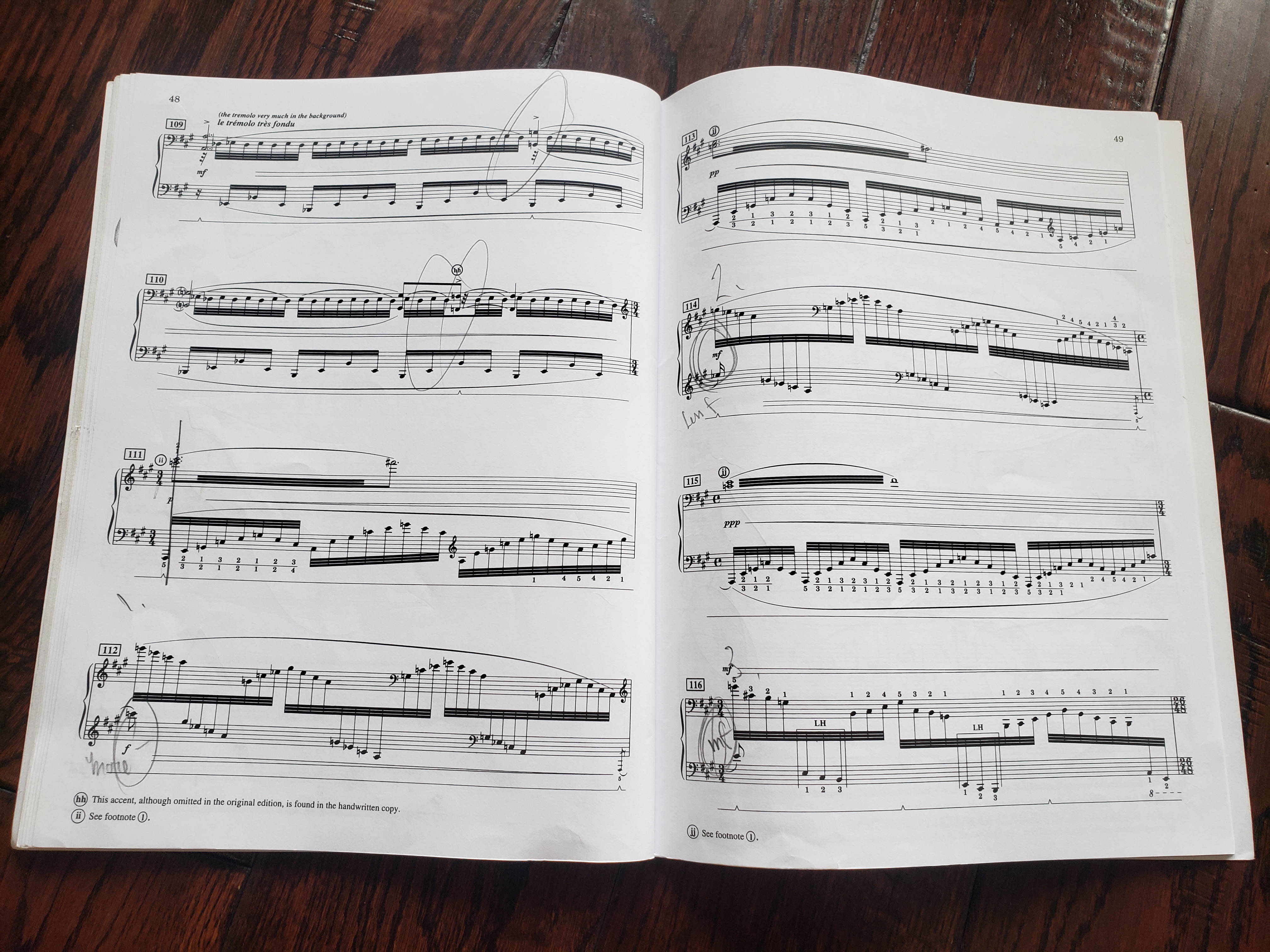

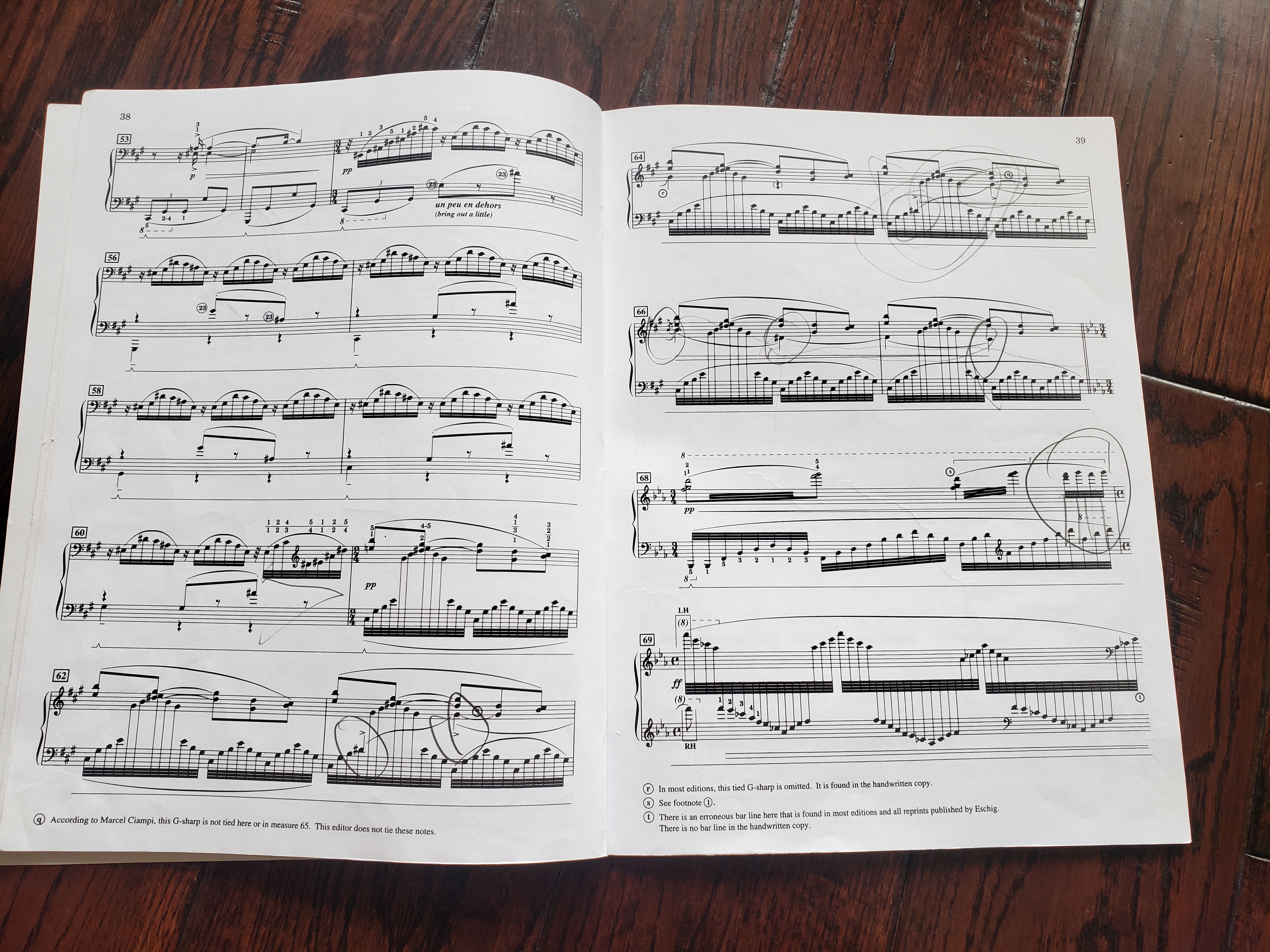
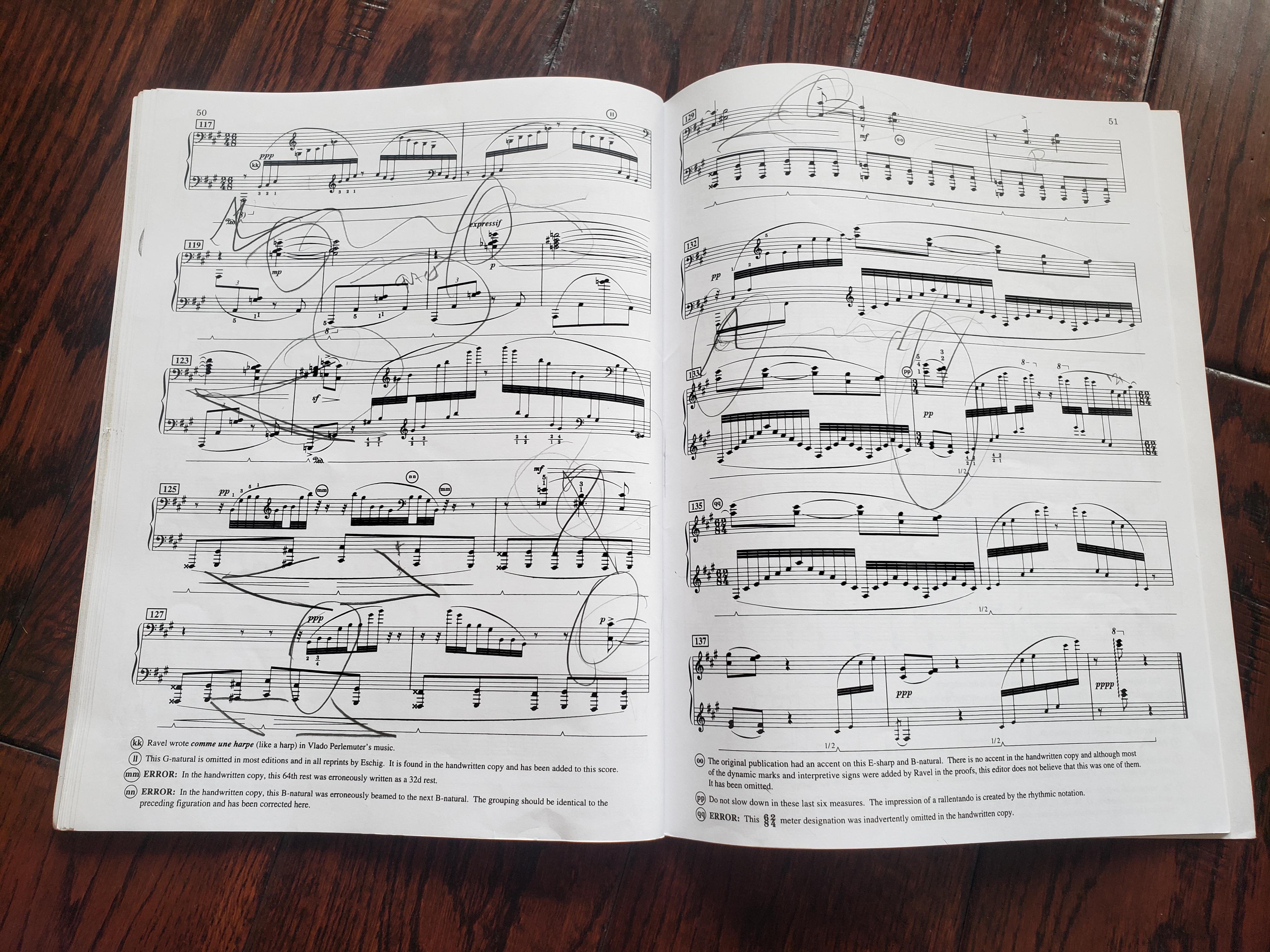
Secondly, the notes didn’t make any sense. The left hand notes on the bottom were grouped in numbers that had no pattern, 12, 6, 8, 7, and 9. Just squashed together randomly, whenever Ravel felt like it. My teacher nodded, waxing poetic about how French composers disregarded the social norms of the time, casting aside old-fashioned ideas to create their own artistic flair.
I am rather fond of social norms, especially when it comes to notes adding up and staying nice and neat.
But the music got worse when I discovered on page 2, that the time signatures were more indecisive than I am.
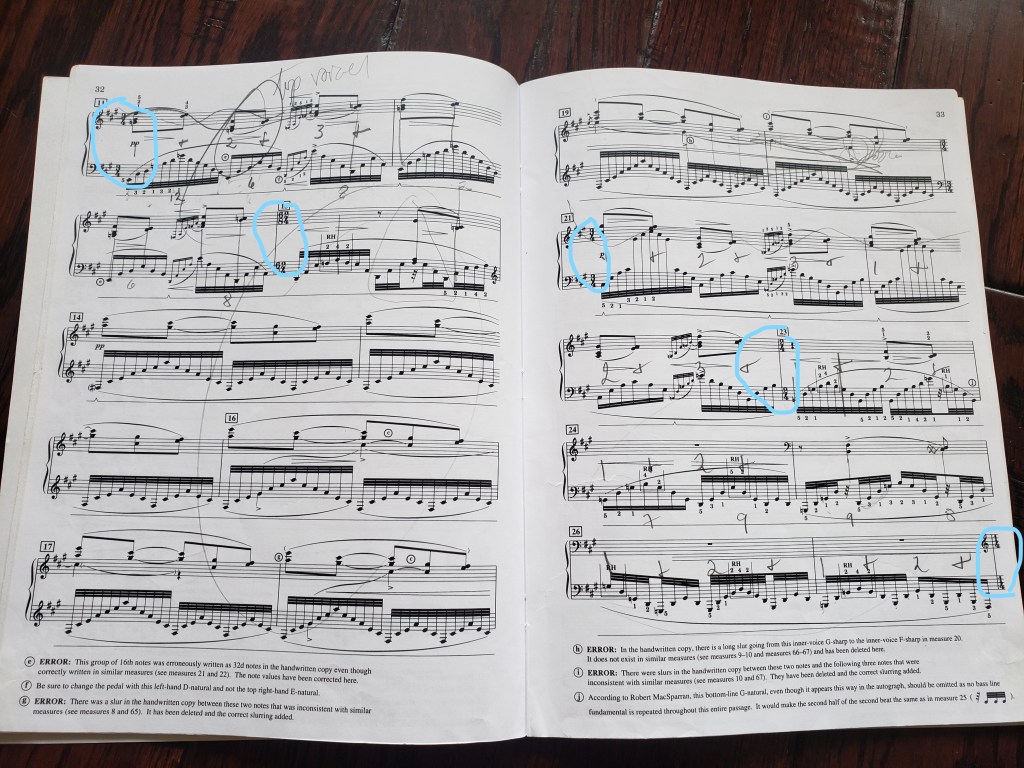
Speaking of time signatures, the one at the very beginning of the piece, the one that is supposed to guide you through all of your rhythm difficulties, the one that is supposed to be your guiding light, your North Star – looked like this:

Yup. A very early indicator that there really isn’t any proper rhythm in this piece, and even if there is, the sheet music certainly isn’t going to help you. In fact, it’s going to make your life more difficult.
Thus began the journey of learning the hardest piece I’ve ever played.

This section comes in the middle of the piece. It is the most tedious part, my least favorite part, because my hands are too small, and I have to widen them until the webbing at the bottom of my fingers is completely stretched out. Like some kind of medieval torture.
Understandably, when this happens, I have a strong desire to throw all caution to the wind and bang the notes as loudly as I can. But this section just so happens to be one of the calm, sweet, quiet moments. I had to exercise discipline, had to create a sense of still waters, had to be elegant and graceful. Otherwise I risked sounding awkward and lumpy.
Did my screaming joints and suspended fingers care about sounding lumpy?
They did not.
But my ears did, and my ears usually take precedent, so I had to suck up the pain and pretend I felt elegant.
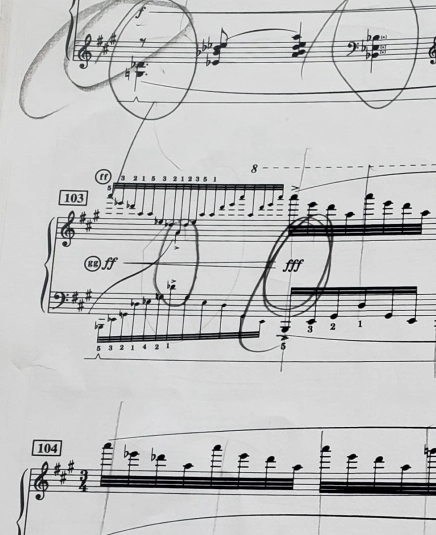
You see those tiny notes? I spent hours on just that part alone, figuring out the notes, trying to get my hands to line up. And I never could get it right. You know what my teacher said? “This section is going so fast and is so loud, you could literally just play the wrong notes and no one would know.”
My secret weapon.
I abandoned the notes, just like they had abandoned me, and my teacher was right. No one noticed.

This piece wasn’t entirely full of pain and suffering. For instance, above is my favorite page: the last one.
But there were also extremely fun runs, where the notes created a trickle of magical sparkles, where I could pound and roar like some kind of sea monster breaking the surface, where I could literally squash random notes down with the back of my hand and it still sounded thrilling.

Above are pages 4 and 5, which took me several long weeks to figure out. Besides the fast trickling notes (easily identifiable by the thick black streaks), the rhythm was the bane of my existence. You can see all the fat numbers my teacher wrote in, trying to pound an inconsistent rhythm into my head.
In fact, after I had been working on this piece for months and attained a solid grasp of the whole thing (meaning, it didn’t completely fall apart in my embrace), these two pages were the ones I always went back to, relentlessly drilling and shouting out numbers and desperately trying to figure out the rhythm.
I was still doing that the morning of the recital, playing these two pages, praying I didn’t mess up, still not understanding what in the seven seas was going on.
But then I realized. This is a piece about the ocean, about the journey of a boat sailing through the different moods of sea. Moods are something that no one understands. And Ravel, being the creative master he was, managed to capture all the complicated nuances of the ocean into musical notes. He captured the wild unpredictability, gentle lapping waters, magnificent roaring swells, mysterious undercurrents, and whispers of creatures in the deep.

I can be a very uptight person. Trying to wrangle life into obeying my decrees. Trying to micromanage everything and assume personal responsibility if everything little thing isn’t perfect.
But you can’t manage the ocean. You can’t manage notes going faster than your eyes can follow them.
What you have to do is…let it go. Embrace the water, trust the slow practice, and let the notes flow through your fingers.
In order for this piece to work, you literally have to stop thinking. Which is hard to do. But when it happens, you feel…suspended from the real world. Like the ghost of Ravel is the one making my fingers work, and I’m just watching, along for the ride.

This masterpiece is breathtaking. Like, literally. When I finished, I was out of breath, and my fingers, wrists, and forearms were aching.
But it was so worth it, and I am honored to share the results with you! I hope you enjoy it.
(Oh, and the memory thing? That was the least difficult part. I labored on this piece for hours upon hours, for months, and by the end of it, I had drilled each stubborn note so many times that it all fell into place, with minimal memory work required. I guess that’s one perk of working on a piece for so long. XD)
Note: I would advise much caution in playing this piece, and would highly recommend only playing it under the guidance and approval of a teacher. It’s technically and physically demanding, and I suspect it played a part in the hand injury that I got a few months later. In fact, I’ve been taking a step back from technically challenging pieces, in an effort to preserve the health of my hands and forearms, and have been focusing on building repertoire and solidifying my existing technique. The piano is more dangerous than it looks, y’all. 😉
Until next time,
Bon Voyage!

If you enjoyed this post, consider clicking here to subscribe to my mailing list!
You will receive an exclusive copy of my fantasy short story, Steps of Fate, plus notifications whenever I post, and you may unsubscribe at any time.
Hope to see you soon! ❤
Wow, Elisha, what a marvelous job! (And yeah, those French guys go crazy, don’t they?) Those meter changes, though … and so many notes … Pianists are just completely impressive, plain and simple. I don’t know how you guys play so many notes so quickly and efficiently and beautifully.
I loved hearing about your practicing and progress! Amazing work, and thank you for sharing a recording, too! 🙂
LikeLiked by 1 person
Awww thank you Vanessa!! Lol violinists are incredible too – fingers move so fast, and there’s so many cool textures, PLUS you have to worry about intonation. 😂
heyyy you should share a violin recording sometime *wink wink nudge nudge*
LikeLiked by 1 person
Hahaha, well, yes, each instrument holds it challenges, that’s for sure! But I’m still blown away by the number of notes you guys process. One of my music professors jokes that pianists should be paid by the note! 🙂
Well … we’ll see about that! 😉 But thanks for that encouragement! 🙂
LikeLiked by 1 person
YES I completely agree – paid by note would be terrific, to make up for the fact that pianists are in so few orchestras, and if they are, there’s only one 😂
LikeLiked by 1 person
WOW THAT IS AMAZING. Those time signatures and just… all of it looks so hard. 😀 And just as impressive!!! It sounded beautiful and majestic – all the little nuances perfectly capturing the ocean! Magnificent performance!!
LikeLiked by 2 people
Aaaaahh thank you Saraina! 😀 I’m so glad you enjoyed it ❤
LikeLiked by 1 person
I love this!! You’ve perfectly captured all the rather stressful feelings that go into learning certain classical pieces, but also just the love of said pieces through the craziness. 😄💛 And wow, I gotta say, I really admire your perseverance in learning this piece! In the end you make it look effortless, and it just sounds so beautiful! *sigh* I am inspired. 😊
LikeLiked by 1 person
Aaahh this made me smile so big! Thank you so much Chalice 😊❤️
LikeLike
The ocean! French! Music! I’m a violinist, not a pianist, and I’m certainly not as good as you are, but I feel the pain…it certainly takes a lot of work to actually get to the rewarding finale. Bravo! 🙂
LikeLiked by 1 person
Eeeee thank you Lily! 😀 So true, with great pain comes great reward. 😉
LikeLiked by 1 person